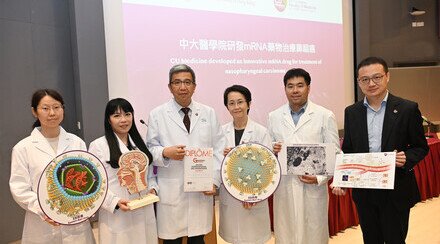CUHK study opens up a new treatment direction for autoimmune eye inflammation
Autoimmune uveitis is a kind of intraocular inflammatory disorder that can lead to permanent blindness. Some patients fail to respond to the steroids that are the current standard treatment, while some develop serious side-effects. Lacking an effective treatment, autoimmune uveitis has become a chronic, recurrent eye disease.
The Chinese University of Hong Kong’s (CUHK) Faculty of Medicine (CU Medicine) conducted a study on autoimmune uveitis and has found its disease mechanism, which opens up a new direction for treatment. Researchers identified a neuroendocrine growth hormone-releasing hormone (GHRH) pathway developing disease-causing T Helper 17 (Th17) cells that promote autoimmune uveitis. The team also discovered existing approved drugs that can suppress the GHRH pathway and could be developed as novel treatments. Details have been published in the international journal Nature Communications.

CU Medicine has found the disease mechanism of autoimmune uveitis, which opens up a new direction for treatment. Researchers identified existing approved drugs that can suppress the disease-causing pathway and could be developed as novel treatments. From left: Postdoctoral Fellow Dr Du Lin, Research Assistant Professor Dr Chu Wai-kit, Chairman and S. H. Ho Professor of Ophthalmology and Visual Sciences Professor Clement CY Tham and Assistant Professor Dr Simon Szeto in the Department of Ophthalmology and Visual Sciences at CU Medicine.
Uveitis is a chronic, recurrent eye disease which is difficult to treat
The uvea is a middle layer of the eye, located between the sclera and the retina, which is also referred to as the vascular tunic. It has functions such as adjusting to different levels of light and supplying nutrients to the eyeball. Uveitis can be infectious and non-infectious. Infectious uveitis is generated by specific agents such as bacteria or viruses, whereas the cause of non-infectious uveitis, including autoimmune uveitis, is normally unknown. Patients frequently exhibit lymphocyte responses to retinal antigens and the disease may lead to autoimmune disorders.

The uvea is a middle layer of the eye, located between the sclera and the retina, which is also referred to as the vascular tunic. It has functions such as adjusting to different levels of light and supplying nutrients to the eyeball.

Professor Clement Tham (left) and Dr Simon Szeto
Professor Clement CY Tham, Chairman and S. H. Ho Professor of Ophthalmology and Visual Sciences in the Department of Ophthalmology and Visual Sciences at CU Medicine, said, “Eye redness, pain and blurred vision are some common symptoms of uveitis. The prevalence of uveitis in China is reportedly about 150 per 100,000 people each year. Though the prevalence is not high, autoimmune uveitis is a chronic, recurrent health problem with no effective cure which bothers many.”
Dr Simon Szeto, Assistant Professor in the Department of Ophthalmology and Visual Sciences at CU Medicine, added, “Steroids are the standard treatment option for autoimmune uveitis but some patients do not respond, and long-term, high-dose steroids can lead to many systemic complications. They may have to seek second-line treatment, including second-line immunosuppressive drugs or biologics, but some patients may still respond poorly or may develop side-effects from these drugs. We therefore see an urgent need to look for new treatment options for autoimmune uveitis patients.”
GHRH antagonist alleviates Th17-mediated ocular inflammation
Researchers from CU Medicine’s Department of Ophthalmology and Visual Sciences used the Experimental Autoimmune Uveitis (EAU), an animal model mimicking human autoimmune uveitis, to investigate the pathogenesis of the eye disease. They found an elevated expression of GHRH and GHRH receptors in the retina of EAU mice. GHRH signalling promotes dysregulation of Th17 cell differentiation, which produces proinflammatory cytokines.

Dr Chu Wai-kit (left) and Dr Du Lin
Dr Chu Wai-kit, Research Assistant Professor in the Department of Ophthalmology and Visual Sciences at CU Medicine, said, “Our study showed GHRH receptors are important regulators of Th17 cell differentiation in Th17 cell-mediated ocular and neural inflammation. Inhibiting the signalling pathway by GHRH antagonists can reduce the number of Th17 cells and suppress autoimmune uveitis. GHRH receptor inhibitors are difficult to translate into clinical use, but we have identified a downstream signalling pathway, JAK-STAT3, along with existing approved drugs that can suppress it and could be developed as novel treatments.”
Dr Du Lin, Postdoctoral Fellow in the Department of Ophthalmology and Visual Sciences at CU Medicine, added, “Th17 can cause other autoimmune diseases, including rheumatoid arthritis and multiple sclerosis. We found GHRH receptors on T cells which promote Th17 cell differentiation in autoimmunity. Under the same theory, GHRH receptor inhibitors can potentially suppress autoimmune neuroinflammation.”


























